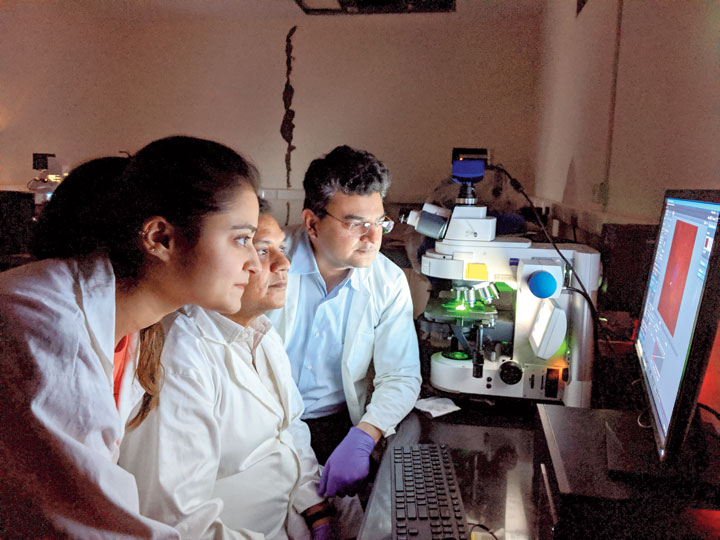Indian scientists have discovered how tuberculosis bacteria hide themselves in the human body and proposed novel strategies that they hope will cure the disease within a month, compared with the six months that the current standard treatment takes.
Their findings challenge a longstanding dogma about tuberculosis infections and suggest that adding a statin-like molecule or immuno-suppressant medicine to current anti-TB treatment may help eliminate the tubercular bacteria, known to persist in the body for years.
These scientists from AIIMS and JNU in New Delhi have shown that tubercular bacilli invade a type of stem cells -– called mesenchymal stem cells -– where they stop replicating, slip into a dormant state and shield themselves from any antibiotics.
Infectious disease specialist Gobardhan Das and his colleagues at the JNU school of molecular medicine are the first to unravel the role of mesenchymal stem cells in persistent TB infections. They published their findings on Friday in The Journal of Clinical Investigation.
Researchers have known for decades that TB bacteria infect certain cells in the body called macrophages where they survive and replicate, getting primed to cause the disease and the symptoms when the immune system falters.
“We’ve found that the TB bacteria hijack the genetic machinery of mesenchymal stem cells and hide within tiny lipid (fat) droplets inside the stem cells, safe from the immune system and safe from antibiotics during anti-TB treatment,” said Das, the study’s principal investigator.
Scientists who have reviewed the work but are not associated with it have described the findings as “striking and innovative” and as a potential “breakthrough” that points towards novel treatment strategies.
“This (study) challenges established dogma and convincingly demonstrates that while macrophages are the natural host for replicating bacteria, mesenchymal stem cells are the natural host for dormant bacilli,” an anonymous reviewer wrote.
“The implications are extensive and open up the possibility of therapeutic intervention of latent (dormant) TB. This therefore represents a major breakthrough.”
Standard anti-TB treatment involves the use of four antibiotics and takes six months or even longer. Most of the tubercular bacilli are cleared from the body within three to four weeks, but a small fraction persists in a dormant state and poses the risk of relapse and drug-resistant TB.
The AIIMS-JNU scientists have in their laboratory studies demonstrated two ways to eliminate the dormant TB bacilli from the stem cells.
In one set of experiments, they found that a molecule called Triacsin-C that blocks fat synthesis could prevent the formation of the protective lipid droplets.
In another, they showed that an immuno-suppressant drug called rapamycin induced in the stem cells a natural waste-ejection process called autophagy, leading to the death of the dormant TB bacilli in the stem cells.
Luc Van Kaer, professor of microbiology at the Vanderbilt University in the US who collaborated with the Indian scientists, said the findings were significant because they suggested potential new therapies that could “chase the bacteria out of their hiding place”.
Scientists, however, have cautioned that although the AIIMS-JNU team has conducted studies in mice, what works in mice may not necessarily work in humans.
The other members of the study team were research scholars Samreen Fatima, Shashank Shivaji, and Depapriya Bhattacharya at the JNU, Santosh Kumar at the International Centre for Genetic Engineering and Biotechnology, New Delhi, and faculty members Sujata Mohanty at AIIMS and Anand Ranganathan at JNU.
Tuberculosis remains a big public health challenge in India.
Over 2.6 million persons developed TB and about 440,000 died from the infection in India during 2018, according to World Health Organisation estimates based on consultations with Indian health authorities.
A senior biologist with expertise on TB bacteria said the 'take-home message' from the AIIMS-JNU research is the possibility of strategies to treat persistent bacteria that lie dormant within mesenchymal stem cells.
'While the standard anti-TB regimen can eliminate active and replicating TB in macrophages, autophagy-inducing drugs such as rapamycin will hopefully result in total elimination of bacteria,' Seyed Hasnain, professor of molecular medicine and vice-chancellor at the Jamia Hamdard University, New Delhi, told The Telegraph.
Hasnain, collaborating with scientists in Hyderabad and Germany, had four years ago proposed that mesenchymal stem cells while providing a safe “resting place” for TB bacteria may also serve as “couriers” transporting the bacteria to different parts of the body leading to non-lung TB.
'These new laboratory findings are wonderful, very encouraging,' Hasnain said. 'But there is need to conduct human clinical trials to take this otherwise excellent study to its logical conclusions.'










